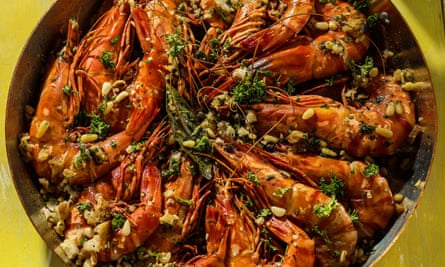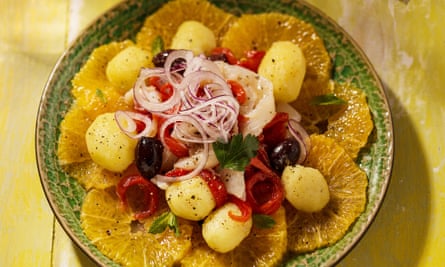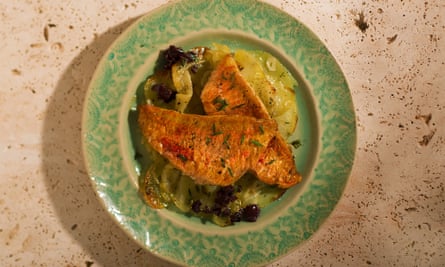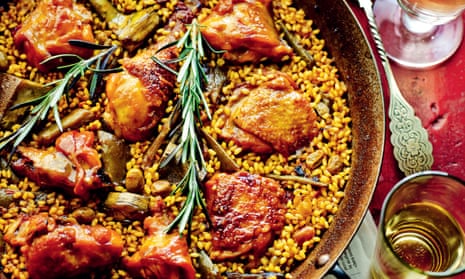Omar Allibhoy’s paella Valenciana: ‘the’ paella
This famous Spanish dish is our equivalent of the Sunday roast, a dish that brings friends and family together. If the weather allows, we cook it on an open fire – you are rewarded with an amazing smoky aroma. This paella recipe is the fruit both of my own investigations and those of top Valencian chefs and grandmothers. Follow this recipe and I guarantee you will soon be tasting the best paella. Buen provecho!
Serves 6
globe artichokes 2-3 (depending on the size), cleaned and trimmed
saffron 1g
salt 1 tbsp
Spanish olive oil 8 tbsp
chicken pieces (on the bone) 400g
rabbit pieces (on the bone) 400g
runner beans 200g, trimmed and cut into 2½cm pieces
broad beans or fresh white butter beans 100g
garlic cloves 4, finely chopped
tomatoes 1 large or 2 small, grated
sweet pimentón ½ tsp
water or light chicken stock 2 litres
Spanish rice 500g, such as calasparra or bomba
rosemary 1 sprig
First prepare the artichokes. Trim the stalks and peel away the outer leaves so you are just left with the artichoke hearts. Scrape away any furry choke with a teaspoon, then run a lemon half over the hearts so they don’t discolour.
Wrap the saffron in foil and toast it for 30 seconds on each side in a paella pan over a medium heat. Remove from the pan and set aside.
Increase the heat to the maximum and season around the edges of the pan with the table salt. Wait until the pan is really hot and then drizzle with the olive oil. It should start smoking immediately; at this point throw in the pieces of chicken and rabbit (the meat needs to absorb the salt at this early stage). Fry the meat until nicely browned on all sides (this will add to the flavour of the paella).
Add the runner beans and broad beans and stir together for 1 minute before adding the garlic. Cook for 1 minute and then add the grated tomatoes (discarding the skin), pimentón and toasted saffron. Cook for 4 minutes, stirring all the time, until you can see that the tomatoes have lost most of the juice and changed colour.
Add the water or chicken stock and leave to simmer for about 20 minutes, allowing the bits of caramelised chicken and vegetable on the bottom of the pan to dissolve so you get a rich stock. If you use chicken stock instead of water you will only need to simmer for 5 minutes. Check the seasoning but bear in mind that the rice will absorb a lot of saltiness, so it’s okay if it tastes quite salty at this stage.
Cut the artichokes into quarters and add to the pan – if you add them any earlier the entire paella will turn dark in colour. Add the rice, spreading it evenly over the paella pan and stir just once. Cook on the highest heat for about 10-12 minutes before reducing the heat right down and cooking for a further 5-7 minutes. Once you have added the rice and given it a good stir you shouldn’t touch the pan with a spoon again. You need to keep the film that develops on the top of the stock from breaking, otherwise the steam will escape and the rice won’t cook evenly.
When the water is at a lower level than the rice itself, add the rosemary sprig. If the layer of rice on the top starts to look a bit crispy, cover the paella pan with a layer of newspaper for the last 5 minutes of cooking. This will help to steam the grains on top while the bottom gets crispy. In Spain this crispy bottom layer, the ‘socarrat’, is the most valuable part of the paella. Once the paella is finished it should look like a completely flat layer of rice. Leave to rest for 5 minutes before serving.
From Tapas Revolution by Omar Allibhoy (Ebury, RRP £20). Click here to buy a copy from Guardian Bookshop for £16; tapasrevolution.com
Colman Andrews’s prawns with garlic and paprika

This particular dish, served at one of the better traditional restaurants in Valencia, El Plat, is made with llagostins, a variety of prawn known scientifically as Penaeus caramote – a particularly large and meaty species. Any kind of prawn will do, though – as fresh as possible, please.
Serves 4
garlic 1 head, separated into cloves, 4 cloves peeled and finely chopped, the rest scored once length ways but unpeeled
olive oil 125ml
fish or shellfish stock 500ml
bay leaf 1
cayenne ½ tsp
salt and pepper
parsley 1 sprig, finely chopped
pine nuts 155g, lightly toasted
fried bread 1 slice, crusts removed
prawns 24 large, heads and shells on
Sauté the unpeeled garlic in the oil for about 10 minutes to flavour the oil, then remove and discard the garlic or set it aside for another use.
Add the fish stock, bay leaf and cayenne to the oil, and salt and pepper to taste. Simmer for about 10 minutes.
Meanwhile, make a picada by crushing the finely chopped garlic, parsley, pine nuts and fried bread in a pestle and mortar. Moisten it with a few drops of the cooking liquid and then stir it into the pot.
Add the prawns to the liquid and simmer for about 5 minutes, or until done.
From Catalan Cuisine by Colman Andrews (Grub Street, RRP £14.99). Click here to buy a copy from Guardian Bookshop for £11.99
Claudia Roden’s ham croquettes

When cold, the bechamel in this recipe firms up quite a bit, making it easier to roll, and when it is fried it becomes creamy inside with a thick, crisp crust. You can prepare the croquettes ready for frying the day before and keep them in the refrigerator.
Makes about 30 croquettes
unsalted butter 75g
onion ½ large, peeled and finely chopped
jamón serrano or other raw dry-cured ham 200g, finely chopped (this can be done in the food processor)
nutmeg freshly grated, a pinch
whole milk 725ml
plain flour 150g
salt if necessary
fine matzo meal or breadcrumbs about 100g
medium matzo meal or breadcrumbs about 125g
eggs 2 large
sunflower or olive oil for deep-frying, enough to cover the croquettes
In a large pan, melt the butter and gently saute the onion over a low heat until it is soft. Add the ham and cook, stirring for a minute or so. Then stir in the nutmeg and about half the milk and bring to the boil.
Beat the flour with the remaining milk using an electric mixer until any lumps have disappeared. Then pour into the pan, stirring vigorously, and cook, continuing to stir constantly, for 8-10 minutes until the mixture has the consistency of a thick paste that comes away from the bottom of the pan. Add salt if necessary – it might not need it because the ham is salty. Chill for at least 2 hours or overnight.
To make the croquettes, cover a large plate with plenty of very fine matzo meal or breadcrumbs and a second plate with medium matzo meal or breadcrumbs. Beat the eggs lightly in a soup plate. Two large spoons greased with oil are normally used to shape the croquetas into an oblong. But you may find it easier, as I do, to take lumps of the thick bechamel paste the size of walnuts and roll them into balls between the palms of your hands. You can rub your hands in oil if you do not want the paste to stick. As you make them, drop the balls into the fine matzo meal or breadcrumbs. Roll a batch of the balls in the fine meal until well covered all over, then roll them in the beaten egg, and then in the medium matzo meal. This will give them a nice thick crust.
To deep-fry the balls in batches in a frying pan, heat the oil until it is only medium hot (until a piece of bread dropped in sizzles immediately but does not turn dark quickly). Carefully lower the croquettes into the oil and fry over a medium-low heat for 5-6 minutes until lightly browned, turning them over once. If the oil is too hot they will burst.
Lift them out with a slotted spoon and drain on kitchen paper. They are best eaten right away.
From The Food of Spain by Claudia Roden (Michael Joseph, RRP £30). Click here to buy a copy from Guardian Bookshop for £25
David Eyre’s bacalao a la malagueña

Serves 4 as a starter
salt cod 400g, dry weight, the thicker the better, soaked in two or three changes of water, in the fridge, for about 48 hours
new potatoes 300g
your best olive oil 150ml
oranges 4, peeled and sliced as thinly as possible, reserving any juice
ground black peppercorns
strong black olives 20
red pepper 1, roasted, peeled and torn into strips
red onion 1 small, very thinly sliced into rounds and then soaked in cold water for 10 minutes
picked parsley and/or mint leaves
Either poach the cod in water until barely cooked and then flake it, dicarding the skin and bones, or tear the uncooked cod into strips. Boil the poatoes and peel them while they are still warm. Gently mix the cod with the olive oil, orange juice, pepper, olives and red pepper. Arrange the orange on 4 plates with the new potatoes. Heap the cod mixture into the centre and garnish with the onion and herbs.
David Eyre is executive chef of Iberian restaurant Eyre Brothers in London EC2; eyrebrothers.co.uk
Jose Pizarro’s red mullet with sliced potatoes and black olives

The best kind of red mullet comes from the Mediterranean, and there are in fact two varieties: Mullus surmuletus, which likes to hang out near rocks, living off smaller fish and crustaceans; and Mullus barbatus, which lives in sandy waters eating all kinds of things.
In Britain, fishmongers tend not to distinguish between the two, selling simply ‘red mullet’, but it is well worth asking for the rock-loving version as it has a much sweeter, clearer flavour. You can identify the fish by the stripes on the first dorsal fin and, when fresh, three or four yellow streaks along its sides. Its profile is slightly more elongated and less snub-nosed than its cousin.
Buy the biggest specimens you can find – no tiddlers please. Each fish should weigh around 400g prior to filleting. Get your fishmonger to fillet them for you – each fish will give you two fillets of around 100g each.
Serves 4
potatoes 3 medium, peeled
extra virgin olive oil 5 tbsp
garlic cloves 2, chopped
thyme 1 sprig, leaves stripped
sea salt and freshly ground black pepper
Aragón or Kalamata black olives 30, pitted
chive stalks 10, chopped
red mullet 4 x 400g, filleted
olive oil for frying
Preheat the oven to 200C/gas mark 6. Slice the potatoes as thinly as possible (use a mandolin if you have one), then mix with 2 tablespoons of olive oil, the chopped garlic and thyme leaves. Season, then spread the mixture over a greased baking tray. Bake for about 15 minutes, until the potatoes are cooked.
Meanwhile, blitz the olives and half the chive stalks with the remaining olive oil in a food processor to make a thick puree.
Season the fillets. Heat some oil in a frying pan until it is medium hot – the oil should be shimmering but not smoking – and fry the mullet for 2 minutes skin-side down, then turn over and fry for another minute. You want a crispy skin.
Divide the potatoes between four plates, pop two fillets on top of each mound and, using a teaspoon, drizzle the plate with the olive puree. Scatter the remaining chives over everything and eat immediately.
From Pizarro: Seasonal Spanish Food by José Pizarro (Kyle Cathie, RRP £15.99). Click here to buy a copy from Guardian Bookshop for £12.79

Comments (…)
Sign in or create your Guardian account to join the discussion